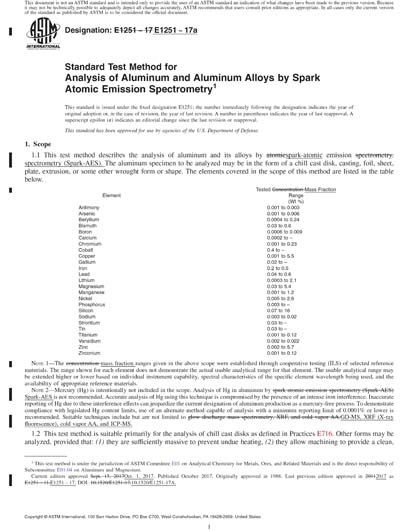Most recent
ASTM E1251-17a Red
Standard Test Method for Analysis of Aluminum and Aluminum Alloys by Spark Atomic Emission Spectrometry (Standard + Redline PDF Bundle)
1.1 This test method describes the analysis of aluminum and its alloys by spark-atomic emission spectrometry (Spark-AES). The aluminum specimen to be analyzed may be in the form of a chill cast disk, casting, foil, sheet, plate, extrusion, or some other wrought form or shape. The elements covered in the scope of this method are listed in the table below.
Note 1: The mass fraction ranges given in the above scope were established through cooperative testing (ILS) of selected reference materials. The range shown for each element does not demonstrate the actual usable analytical range for that element. The usable analytical range may be extended higher or lower based on individual instrument capability, spectral characteristics of the specific element wavelength being used, and the availability of appropriate reference materials.
Note 2: Mercury (Hg) is intentionally not included in the scope. Analysis of Hg in aluminum by Spark-AES is not recommended. Accurate analysis of Hg using this technique is compromised by the presence of an intense iron interference. Inaccurate reporting of Hg due to these interference effects can jeopardize the current designation of aluminum production as a mercury-free process. To demonstrate compliance with legislated Hg content limits, use of an alternate method capable of analysis with a minimum reporting limit of 0.0001% or lower is recommended. Suitable techniques include but are not limited to GD-MS, XRF (X-ray fluorescence), cold vapor AA, and ICP-MS.
1.2 This test method is suitable primarily for the analysis of chill cast disks as defined in Practices E716. Other forms may be analyzed, provided that: (1) they are sufficiently massive to prevent undue heating, (2) they allow machining to provide a clean, flat surface, which creates a seal between the specimen and the spark stand, and (3) reference materials of a similar metallurgical condition and chemical composition are available.
1.3 This standard does not purport to address all of the safety concerns, if any, associated with its use. It is the responsibility of the user of this standard to establish appropriate safety, health, and environmental practices and determine the applicability of regulatory limitations prior to use. Specific safety and health statements are given in Section 10.
1.4 This international standard was developed in accordance with internationally recognized principles on standardization established in the Decision on Principles for the Development of International Standards, Guides and Recommendations issued by the World Trade Organization Technical Barriers to Trade (TBT) Committee.
ASTM International [astm]

